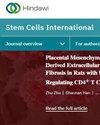从人脐带血间充质干细胞中提取的细胞外小泡对非肥胖小鼠细胞免疫的影响
IF 3.3
3区 医学
Q2 CELL & TISSUE ENGINEERING
引用次数: 0
摘要
自身免疫反应是1型糖尿病(T1D)最重要的致病机制。从间充质干细胞(MSCs)中提取的细胞外囊泡(EVs)具有免疫调节作用。在这项研究中,我们探讨了从人脐带间充质干细胞(HucMSC-EVs)中提取的EVs是否对作为T1D模型的非肥胖糖尿病(NOD)小鼠有治疗作用。从人脐带间充质干细胞中分离出 HucMSC-EVs,并对其进行表征。通过尾静脉注射 HucMSC-EVs 或相同体积的磷酸盐缓冲盐水(PBS)给 NOD 小鼠(4 周龄),每周两次。治疗 8 周后,收集血液、脾脏和胰腺样本。在治疗期间测量小鼠血糖水平和体重,并通过酶联免疫吸附试验(ELISA)分析胰岛素浓度和炎症细胞因子水平。血红素和伊红(H&E)染色和免疫组织化学(IHC)染色用于评估小鼠胰岛的病理变化。流式细胞术评估了T淋巴细胞亚群,而定量实时聚合酶链反应(qRT-PCR)和Western印迹(WB)分析则用于检测转录因子和炎症细胞因子的表达。我们的数据表明,HucMSC-EVs 治疗可降低 NOD 小鼠的血糖水平并提高胰岛素浓度。HucMSC-EVs组白细胞介素-2(IL-2)、IL-4和IL-10的水平显著升高,IL-1β和干扰素-γ(IFN-γ)的水平显著降低。静脉注射 HucMSC-EVs 后,CD4+ T 淋巴细胞亚群的阳性比例下降,其中 Th2 细胞比例上升,Th1 细胞比例下降。HucMSC-EVs治疗后,脾脏中GATA-3和IL-2、IL-4和IL-10的表达水平上调,而T-bet和IFN-γ的表达水平下调。此外,在对照组小鼠的胰腺中检测到的炎性细胞浸润多于接受 HucMSC-EVs 治疗的小鼠。IHC 染色显示,对照组小鼠胰腺中 Fas/FasL 的表达和分布高于 HucMSC-EVs 组。综上所述,我们的研究结果表明,HucMSC-EVs 有可能通过调节 Th1/Th2 比率来调节炎症因子的分泌,从而通过 T 细胞免疫反应预防胰岛损伤。本文章由计算机程序翻译,如有差异,请以英文原文为准。
Effects of Extracellular Vesicles Derived from Human Umbilical Cord Blood Mesenchymal Stem Cells on Cell Immunity in Nonobese Mice
Autoimmune responses are the most important pathogenic mechanisms underlying type 1 diabetes (T1D). Extracellular vesicles (EVs) derived from mesenchymal stem cells (MSCs) have immunomodulatory effects. In this study, we investigated whether EVs derived from human umbilical cord MSCs (HucMSC-EVs) have treatment effects on nonobese diabetic (NOD) mice as model of T1D. HucMSC-EVs were isolated from human umbilical cord MSCs and characterized. NOD mice (aged 4 weeks) were administered with HucMSC-EVs or the same volume of phosphate-buffered saline (PBS) via caudal vein injection twice per week. After 8 weeks of treatment, blood, spleen, and pancreatic samples were collected. Mouse blood glucose levels and body weights were measured during treatment, and insulin concentration and inflammatory cytokine levels were analyzed by enzyme-linked immunosorbent assay (ELISA). Hematoxylin and eosin (H&E) staining and immunohistochemistry (IHC) staining were used to evaluate pathological changes in mouse islets. T lymphocyte subsets were evaluated by flow cytometry, while quantitative real-time polymerase chain reaction (qRT-PCR) and Western blot (WB) analyses were used to detect the expression of transcription factor and inflammatory cytokines. Our data indicated that HucMSC-EVs treatment reduced blood glucose levels and increased insulin concentration in NOD mice. Levels of interleukin-2 (IL-2), IL-4, and IL-10 were significantly increased and those of IL-1β and interferon-γ (IFN-γ) significantly decreased in the HucMSC-EVs group. The positive ratio of CD4+ T lymphocyte subsets decreased after intravenous injection of HucMSC-EVs, in which the proportion of Th2 cells increased and that of Th1 decreased. GATA-3 and IL-2, IL-4 and IL-10 expression levels were upregulated in spleen on treatment with HucMSC-EVs, whereas those of T-bet and IFN-γ were downregulated. In addition, more inflammatory cell infiltration was detected in the pancreas of control group mice than those treated with HucMSC-EVs. IHC staining showed that Fas/FasL expression and distribution in control group pancreas were higher than those in the HucMSC-EVs group. Together, our findings indicate that HucMSC-EVs have potential to prevent islet injury via T cell immune responses by adjusting the Th1/Th2 ratio to regulate secretion of inflammatory factors.
求助全文
通过发布文献求助,成功后即可免费获取论文全文。
去求助
来源期刊

Stem Cells International
CELL & TISSUE ENGINEERING-
CiteScore
8.10
自引率
2.30%
发文量
188
审稿时长
18 weeks
期刊介绍:
Stem Cells International is a peer-reviewed, Open Access journal that publishes original research articles, review articles, and clinical studies in all areas of stem cell biology and applications. The journal will consider basic, translational, and clinical research, including animal models and clinical trials.
Topics covered include, but are not limited to: embryonic stem cells; induced pluripotent stem cells; tissue-specific stem cells; stem cell differentiation; genetics and epigenetics; cancer stem cells; stem cell technologies; ethical, legal, and social issues.
 求助内容:
求助内容: 应助结果提醒方式:
应助结果提醒方式:


